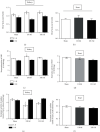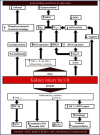Characterization of the Oxidative Stress in Renal Ischemia/Reperfusion-Induced Cardiorenal Syndrome Type 3
- PMID: 33102574
- PMCID: PMC7568802
- DOI: 10.1155/2020/1605358
Characterization of the Oxidative Stress in Renal Ischemia/Reperfusion-Induced Cardiorenal Syndrome Type 3
Abstract
In kidney disease (KD), several factors released into the bloodstream can induce a series of changes in the heart, leading to a wide variety of clinical situations called cardiorenal syndrome (CRS). Reactive oxygen species (ROS) play an important role in the signaling and progression of systemic inflammatory conditions, as observed in KD. The aim of the present study was to characterize the redox balance in renal ischemia/reperfusion-induced cardiac remodeling. C57BL/6 male mice were subjected to occlusion of the left renal pedicle, unilateral, for 60 min, followed by reperfusion for 8 and 15 days, respectively. The following redox balance components were evaluated: catalase (CAT), superoxide dismutase (SOD), total antioxidant capacity (FRAP), NADPH oxidase (NOX), nitric oxide synthase (NOS), hydrogen peroxide (H2O2), and the tissue bioavailability of nitric oxide (NO) such as S-nitrosothiol (RSNO) and nitrite (NO2 -). The results indicated a process of renoprotection in both kidneys, indicated by the reduction of cellular damage and some oxidant agents. We also observed an increase in the activity of antioxidant enzymes, such as SOD, and an increase in NO bioavailability. In the heart, we noticed an increase in the activity of NOX and NOS, together with increased cell damage on day 8, followed by a reduction in protein damage on day 15. The present study concludes that the kidneys and heart undergo distinct processes of damage and repair at the analyzed times, since the heart is a secondary target of ischemic kidney injury. These results are important for a better understanding of the cellular mechanisms involved in CRS.
Copyright © 2020 Wellington Caio-Silva et al.
Conflict of interest statement
The authors declare that they have no conflict of interest.
Figures





Similar articles
-
Reactive oxygen species generated by renal ischemia and reperfusion trigger protection against subsequent renal ischemia and reperfusion injury in mice.Am J Physiol Renal Physiol. 2010 Jan;298(1):F158-66. doi: 10.1152/ajprenal.00474.2009. Epub 2009 Oct 28. Am J Physiol Renal Physiol. 2010. PMID: 19864300
-
NAD(P)H oxidase, superoxide dismutase, catalase, glutathione peroxidase and nitric oxide synthase expression in subacute spinal cord injury.Brain Res. 2004 Jan 2;995(1):76-83. doi: 10.1016/j.brainres.2003.09.056. Brain Res. 2004. PMID: 14644473
-
Reactive oxygen species/oxidative stress contributes to progression of kidney fibrosis following transient ischemic injury in mice.Am J Physiol Renal Physiol. 2009 Aug;297(2):F461-70. doi: 10.1152/ajprenal.90735.2008. Epub 2009 May 20. Am J Physiol Renal Physiol. 2009. PMID: 19458120
-
Teaching the basics of redox biology to medical and graduate students: Oxidants, antioxidants and disease mechanisms.Redox Biol. 2013 Feb 8;1(1):244-57. doi: 10.1016/j.redox.2013.01.014. Redox Biol. 2013. PMID: 24024158 Free PMC article. Review.
-
Oxidant Mechanisms in Renal Injury and Disease.Antioxid Redox Signal. 2016 Jul 20;25(3):119-46. doi: 10.1089/ars.2016.6665. Epub 2016 Apr 26. Antioxid Redox Signal. 2016. PMID: 26906267 Free PMC article. Review.
Cited by
-
Metabolomics in Acute Kidney Injury: The Experimental Perspective.J Clin Med Res. 2023 Jun;15(6):283-291. doi: 10.14740/jocmr4913. Epub 2023 Jun 29. J Clin Med Res. 2023. PMID: 37434774 Free PMC article. Review.
-
Tyrosine and Tryptophan vibrational bands as markers of kidney injury: a renocardiac syndrome induced by renal ischemia and reperfusion study.Sci Rep. 2021 Jul 22;11(1):15036. doi: 10.1038/s41598-021-93762-z. Sci Rep. 2021. PMID: 34294750 Free PMC article.
-
The Molecular Mechanism and Therapeutic Strategy of Cardiorenal Syndrome Type 3.Rev Cardiovasc Med. 2023 Feb 6;24(2):52. doi: 10.31083/j.rcm2402052. eCollection 2023 Feb. Rev Cardiovasc Med. 2023. PMID: 39077418 Free PMC article. Review.
-
Bone Marrow Mononuclear Cells Restore Normal Mitochondrial Ca2+ Handling and Ca2+-Induced Depolarization of the Internal Mitochondrial Membrane by Inhibiting the Permeability Transition Pore After Ischemia/Reperfusion.Cell Transplant. 2022 Jan-Dec;31:9636897221085883. doi: 10.1177/09636897221085883. Cell Transplant. 2022. PMID: 35343271 Free PMC article.
-
Experimental Cardiorenal Syndrome Type 3: What Is Known so Far?J Clin Med Res. 2022 Jan;14(1):22-27. doi: 10.14740/jocmr4639. Epub 2022 Jan 29. J Clin Med Res. 2022. PMID: 35211213 Free PMC article. Review.
References
-
- Li Q., Wei G., Tao T. Leukocyte immunoglobulin-like receptor B4 (LILRB4) negatively mediates the pathological cardiac hypertrophy by suppressing fibrosis, inflammation and apoptosis via the activation of NF-κB signaling. Biochemical and Biophysical Research Communications. 2019;509(1):16–23. doi: 10.1016/j.bbrc.2018.11.137. - DOI - PubMed
MeSH terms
Substances
LinkOut - more resources
Full Text Sources
Miscellaneous

